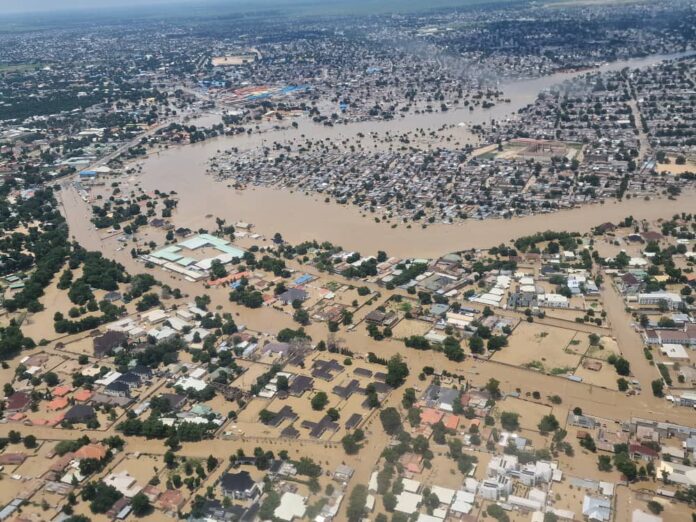By Dr. Musa Abdullahi Sufi Freelance and Development Journalist (SIDES Media)
As climate change intensifies, the risk of dam breaks and catastrophic flooding has risen dramatically. Around the world, communities living near large dams face increasing threats from extreme weather events, exacerbated by outdated infrastructure and insufficient preventive measures.
The case of Alau Dam in Maiduguri, Nigeria, provides a sobering example of the devastating effects of dam failure and the urgent need for coordinated global and local responses.
A History of Tragedy: The Case of Alau Dam
Constructed in 1986, Alau Dam was a vital source of water for the region’s agricultural activities, providing irrigation and drinking water for Maiduguri and surrounding areas. However, on September 13th 1994, the dam suffered a catastrophic break, displacing approximately 400,000 people and causing widespread property damage.
The disaster, which occurred under the regime of the late General Sani Abacha, brought the region to its knees and highlighted the vulnerabilities of ageing infrastructure.
Fast forward to September 10th, 2024, and tragedy struck again. Following unprecedented rainfall linked to climate change, Alau Dam failed once more, displacing millions of people and claiming numerous lives.
The resulting floodwaters devastated homes, businesses, and farmlands, forcing thousands into temporary shelters. This latest incident underscores the urgent need for coordinated, proactive responses to mitigate future risks and protect vulnerable communities.
Understanding the Impact of Climate Change
As global temperatures rise, extreme weather events, including heavy rains and storms, have become more frequent and severe. Climate change accelerates the risk of dam failure by increasing the volume and intensity of rainfall, overwhelming the capacity of ageing dam structures. In many cases, these dams were not built to withstand the magnitude of weather patterns we are now seeing, making them increasingly vulnerable to collapse.
Research shows that dam breaks and flooding are projected to become more common across Africa, Asia, and other regions. These disasters pose a serious threat to food security, water supply, and infrastructure, particularly in developing countries with limited resources for maintaining and upgrading dams.
Improving Coordination and Collaboration
A key lesson from the Alau Dam disaster is the need for stronger coordination among various actors at the international, national, and local levels. Preventing dam failure and responding effectively when it happens requires collaboration between governments, international organizations, civil society, communities and other stakeholders.
International Collaboration: Countries must come together to share research and technology on dam management, climate adaptation, and disaster preparedness. International organizations like the UN, World Bank, and humanitarian groups play a crucial role in providing expertise, funding, and technical support to developing nations at risk of dam failure.
Additionally, regional cooperations like the African Union (AU), the Economic Community of West African States (ECOWAS) and others are essential for managing shared water resources and mitigating cross-border flood risks.
National and State-Level Coordination: Governments at all levels must work closely to ensure that safety protocols are in place and adhered to. In Nigeria, coordination between local governments, states, and federal authorities is crucial to ensuring timely response, early warning systems, and the implementation of safety checks on critical infrastructure like dams.
Community Involvement: Engaging local communities in dam safety efforts is vital for early detection and emergency response. Awareness campaigns should be implemented to educate residents on the dangers of dam failure and flooding, along with evacuation procedures. In vulnerable regions, early-warning systems—backed by real-time data—can save lives by providing communities with the information they need to evacuate before disaster strikes.
Policies, Laws, and Resettlement Schemes
To safeguard communities, countries need robust policies and legal frameworks designed to prevent dam failures and minimize their impact. These measures should include:
Dam Safety Regulations: Countries should adopt, adapt and enforce international best practices in dam design, maintenance, and monitoring. Regular safety inspections are critical to identifying weaknesses in ageing infrastructure before disaster strikes.
Climate Resilience Planning: National and regional policies must incorporate climate resilience into infrastructure planning. This includes strengthening dams to withstand extreme weather events, retrofitting older dams, and building new structures to higher safety standards.
Resettlement Programs: In areas where dams are at high risk of failure, resettlement schemes should be developed to relocate people from flood-prone areas to safer zones. This is especially important for informal settlements that often spring up near dam sites.
Case Study: Alau Dam and the Need for Action
The 2024 10th September Alau Dam disaster serves as a stark reminder of the urgent need for policy change and infrastructure investment. The Nigerian government, working with local and international partners, must prioritize the rehabilitation of ageing dams to avoid future tragedies.
Immediate steps should include strengthening the structural integrity of Alau Dam, establishing a regional disaster management framework, and investing in modern flood prevention technologies. Equally important is the role of development partners, civil society organizations (CSOs), academia, and the philanthropic community.
These actors should support research initiatives, capacity-building programs, and funding for climate adaptation projects. Academia, in particular, can play a crucial role by conducting studies on climate impacts and dam safety, while CSOs can raise public awareness and advocate for policy reforms.
Conclusion: A Collective Responsibility
The catastrophic effects of dam breaks, such as those witnessed at Alau Dam, require urgent and coordinated action from governments, communities, and the international community. As climate change accelerates, so too must our efforts to prepare for and respond to dam failures and flooding.
Through improved research, coordination, awareness, and the implementation of preventive policies, we can protect millions of lives from the devastating effects of climate-induced disasters.
As the global climate crisis worsens, proactive measures must become the norm rather than the exception.
The recent Alau Dam collapse demonstrates that collective responsibility is needed to safeguard the future of vulnerable communities. By working together, we can prevent future tragedies and build resilience against the growing threats posed by climate change.
SIDES Media Sufi Innovation and Development Solutions – SIDES




